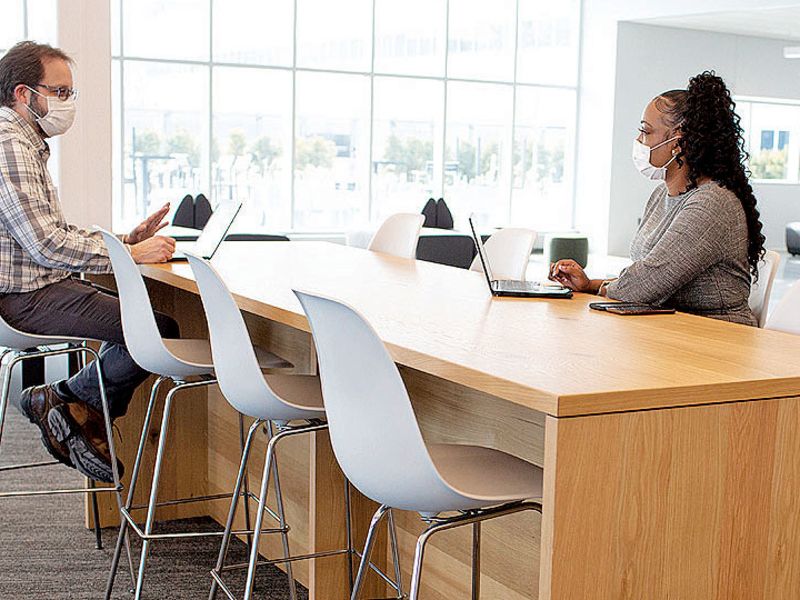
DETROIT — After nearly two decades of dutifully commuting to Ford Motor Co.’s campus in Dearborn, Mich., whether or not she needed to be there, Kelly Keller, a chemistry lab and material compliance manager, discovered over the past year that she and her team can be productive from home.
“For me, it’s two hours I have to do work instead of sitting in a car in traffic,” Keller told Automotive News. “It’s one of the good sides of the pandemic. The work is still getting done, and I think Ford sees that.”
Just over 12 months after COVID-19 prompted a mandatory office exile, Ford last week told tens of thousands of salaried employees that they can continue at least some at-home work on a permanent basis. The hybrid schedule is a drastic paradigm shift for a traditional manufacturer and could prompt a larger modernization for an industry accustomed to 20th century cubicle farms and conference rooms.
“No one would have imagined this being possible two years ago,” said Adam Robinson, CEO of Hireology, a hiring technology platform that works with automotive retailers. “When Facebook did it, people said, ‘OK, well, tech companies do that kind of thing.’ When Ford does it, employers really need to take notice. They’ve set a standard. It’s not only the right policy, it’s going to be table stakes to be at the top of the game in recruiting.”
Ford said the decision was prompted by a 10-week examination of the future of work, as well as a survey that found 95 percent of its workers around the globe preferred to continue some degree of remote work. Robinson said Hireology’s own studies show similar results.
“Over the course of the last year, workers have grown to appreciate the flexibility their employers have given them, and they want to keep it,” he said. “Employers who continue to give it to them and continue to cater to the needs of their work force are going to win the talent war. Those who do not evolve to a hybrid model where they could do so will be at a distinct disadvantage in the market.”
Ford said it still has 30,000 employees in North America who are working remotely full time, and that will be the case until at least the end of June.
Crosstown rival General Motors last week said it plans to bring back its remote work force in the summer, but spokesman David Caldwell said some degree of remote work likely will continue.
“The future will be more flexible,” Caldwell said in an email. “We are seeking to maintain the benefits of remote work, while also ensuring our teams get the benefit of in-person collaboration.”
Stellantis, the company formed from the merger of Fiat Chrysler Automobiles and PSA Group, has not yet announced a return-to-work policy for its employees.
Whenever employees return to the office, it probably will look different from what they remember.
Ford said it would invest in new technology and reorganize some buildings with a heavier focus on collaborative spaces instead of individual desks. That’s because it anticipates most employees would return only for larger meetings, workshops or team-building activities they can’t do from home.
“We know there’s a strong contingent who wants that flexibility to choose where to work,” Jackie Shuk, global director of Ford Land, the automaker’s real estate arm, told Automotive News. “The onus is on us to make sure, when they do come on-site, we give them the space to be their most productive.”
The shift in thinking is sure to factor into Ford’s ongoing Dearborn campus redesign, which it revealed in 2016 and updated in 2019. While the automaker for years has been trying to predict the future of work, Robinson said it was virtually impossible to see the changes wrought by the coronavirus pandemic.
“This has propelled employers toward hybrid work by a decade,” he said. “It’s been an accelerant for a trend that was growing slowly.”
Keller, the Ford manager, essentially has been beta testing the hybrid approach since the middle of 2020, when Michigan relaxed safety restrictions and allowed for some site-dependent work.
One of the two groups she manages works in a chemistry lab, which can’t be replicated in a spare bedroom or basement. The other group usually communicates with suppliers over the phone or by sharing documents and spreadsheets on computers.
Most weeks, Keller splits time between the lab and her home office. She said Ford has been accommodating about providing office chairs or extra monitors for at-home setups.
The employees she supervises who can work from home enjoy it, she said, although most still want to go into the office and interact in person a few days a week once it’s deemed safe to do so.
“I definitely find my team is as productive or even more productive in their at-home time, just because in most cases there are a lot less distractions,” she said. “It’s good to see people face-to-face, and it’s an important part of being a team. It’s the upside to hybrid because you get a little bit of both. I think a lot of people have longed for that.”

